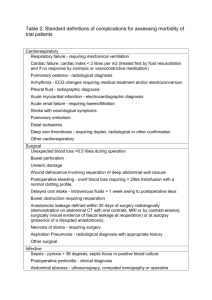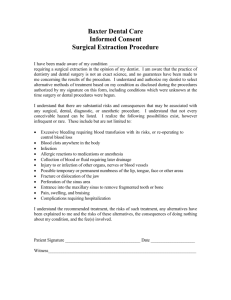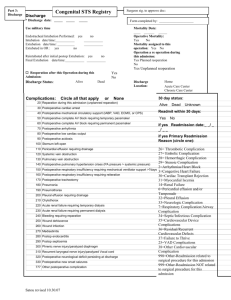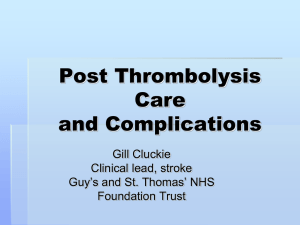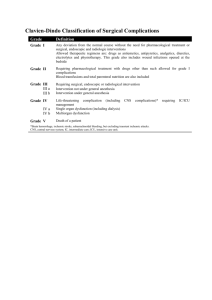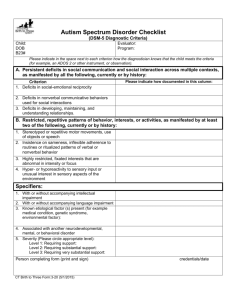Methods
advertisement
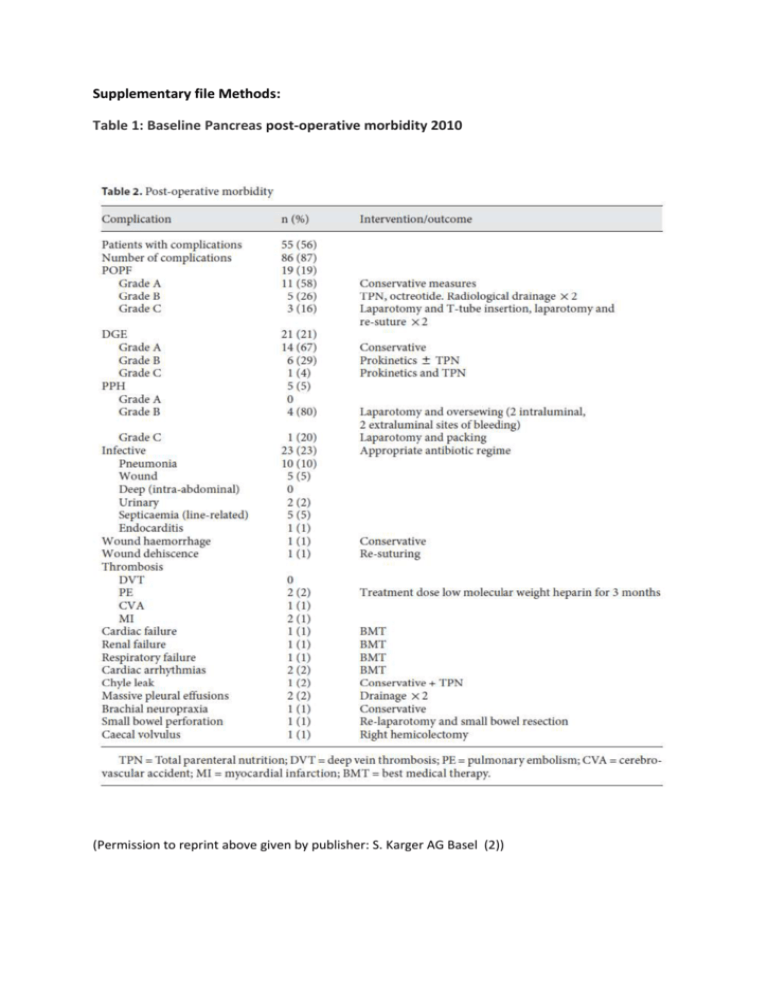
Supplementary file Methods: Table 1: Baseline Pancreas post-operative morbidity 2010 (Permission to reprint above given by publisher: S. Karger AG Basel (2)) Figure 1: Pancreas post-operative complications according to the ISGPS definitions (2) (Permission to reprint above given by publisher: S. Karger AG Basel (2)) Supplementary file: The HPB QIP Proforma Patient Demographics: Name Unit Number DOB Consultant Operative Details: Operation Date Time Operating surgeon Elective / Emergency Complication Codes: (Please note date diagnosis made if applicable) Code Complication A Pancreatic fistula B Delayed gastric emptying C D Post pancreatectomy Haemorrhage Bile leak E Liver failure F Post hepatectomy haemorrhage G Cardiac H Pulmonary I DVT/PE J Wound K Other L Readmission within 30 days M Death N Unplanned return to theatre Grade Justified Error Action Plan A: Pancreatic fistula (ISGPF) ISGPF Definition: “Output via an operatively placed drain (or a subsequently placed percutaneous drain) of any measurable volume of drain fluid on or after postoperative d 3, with an amylase content greater than 3 times the upper normal serum value” Grade A “Transient fistula” No clinical impact No peri-pancreatic collections on CT scan; little/no change in management High drain amylase but nil else needed Clinically well; no sepsis; no prolongation of hospital stay; slow removal of operatively placed drains Grade B Clinical impact Peri-pancreatic drains in place or repositioned to drain collections; Change in management is required Clinically fairly well; degree of infection requiring specific treatment; prolongation of hospital stay; patients often discharged with drains in situ and observed in outpatient setting Grade C Severe clinical impact Worrisome peri-pancreatic collections that require percutaneous drains; major change in management usually in ICU setting; possible re-surgery to salvage a difficult situation (completion pancreatectomy etc) Clinically unwell; associated sepsis requiring aggressive antibiotics, octreotide and other intensive care support; major prolongation of hospital stay; associated complications B: Delayed gastric emptying (ISGPF) Grade A Need for NGT intubation for 4 d or NGT reinsertion after postoperative day (POD) 3, or inability to tolerate a solid diet by POD 7. Grade B Need for NGT intubation for 8 d or NGT reinsertion after POD 7, or inability to tolerate a solid diet by POD 14. Grade C Need for NGT intubation for 15 d or NGT reinsertion After POD 15 C: Post Pancreatectomy haemorrhage (ISGPF) Grade A Grade B Grade C Onset, location, presentation and severity Early, intra or extraluminal mild Condition Diagnosis Treatment Well No Early, intra or extraluminal severe OR Late, intra or extraluminal, mild Late intra or extraluminal, severe Often well/intermediate Very rarely lifethreatening Observation, blood count, USG and, if necessary CT Observation, blood count, USG, angiography, CT endoscopy Severely impaired life-threatening Angiography, CT endoscopy Transfusion of fluid/blood, ICU, therapeutic embolisation relaparotomy for early PPH Localisation of bleeding, angiography and embolisation, (endoscopy) or relaparotomy, ICU D: Bile Leak (ISGLS) ISGLS definition: ‘Bile leakage is defined as fluid with an increased bilirubin concentration in the abdominal drain or in the intra abdominal fluid on or after post operative day 3, or as the need for radiologic intervention because of biliary collections or relaparotomy resulting from bile peritonitis. Increased bilirubin concentration in the drain is defined as at least 3 times greater than the serum bilirubin concentration measured at the same time.’ Grade A Bile leakage requiring no or little change in patients clinical management Grade B Bile leakage requiring a change in patients clinical management (eg additional diagnostic or interventional procedures) but manageable without re laparotomy or grade A lasting > 1 week Bile leakage requiring re laparotomy Grade C E: Liver failure (ISGLS) ISGLS definition: ‘A postoperatively acquired deterioration in the ability of the liver (in patients with normal and abnormal liver function) to maintain its synthetic, excretory, and detoxifying functions, characterized by an increased INR (or need of clotting factors to maintain normal INR) and hyperbilirubinemia (according to the normal cut-off levels defined by the local laboratory) on or after postoperative day 5. If INR or serum bilirubin concentration is increased preoperatively, PHLF is defined by an increasing INR (decreasing prothrombin time) and increasing serum bilirubin concentration on or after postoperative day 5 (compared with the values of the previous day). Other obvious causes for the observed biochemical and clinical alterations such as biliary obstruction should be ruled out.’ Grade A Grade B Grade C PHLF resulting in abnormal laboratory parameters but requiring no change in the clinical management of the patient PHLF resulting in a deviation from the regular clinical management but manageable without invasive treatment PHLF resulting in a deviation from the regular clinical management and requiring invasive treatment F: Post hepatectomy haemorrhage (ISGLS) ISGLS definition: ‘Post-hepatectomy haemorrhage (PHH) is defined as a drop of haemoglobin level >3 g/dl after the end of surgery compared to postoperative baseline level and/or any postoperative transfusion of PRBCs for a falling hemoglobin and/or the need for invasive re-intervention (e.g. embolization or re-laparotomy) to stop bleeding. To diagnose PHH (and to exclude other sources of haemorrhage) evidence of intraabdominal bleeding should be obtained such as frank blood loss via the abdominal drains if present (e.g. haemoglobin level in drain fluid >3 g/dl) or detection of an intra-abdominal haematoma or active haemorrhage by abdominal imaging (ultrasound, CT, angiography). Patients who are transfused immediately postoperatively for intra-operative blood loss by a maximum of two units of PRBCs (i.e. who do not have evidence of active haemorrhage) are not diagnosed with PHH.’ Grade A PHH requiring transfusion of up to 2 units of RBC’S Grade B PHH requiring transfusion of >2 units of RBC’S but manageable without invasive intervention Grade C PHH requiring radiological interventional treatment (e.g. embolization) or re laparotomy G-L: Grade as per Clavien System: Grade I Grade II Grade III Grade IV Grade V Any deviation from the normal postoperative course without the need for pharmacological treatment or surgical, endoscopic, and radiological interventions Allowed therapeutic regimens are: drugs as antiemetics, antipyretics, analgetics, diuretics, electrolytes, and physiotherapy. This grade also includes wound infections opened at the bedside Requiring pharmacological treatment with drugs other than such allowed for grade I complications Blood transfusions and total parenteral nutrition are also included Requiring surgical, endoscopic or radiological intervention Grade IIIa - Intervention not under general anesthesia Grade IIIb - Intervention under general anesthesia Life-threatening complication (including CNS complications)* requiring IC/ICU management Grade IVa Single organ dysfunction (including dialysis) Grade IVb Multiorgan dysfunction Death of a patient *Brain hemorrhage, ischemic stroke, subarrachnoidal bleeding, but excluding transient ischemic attacks. CNS, central nervous system; IC, intermediate care; ICU, intensive care unit. M: Death analysis A Non preventable: Requires that: 1) To a resonable degree of medical certainty, outcome would have been the same regardless of any errors 2) No substantive errors were made and identified C B Possibly preventable: Requires that: 1) Substantive errors made and identified 2) Errors were prospective or retrospective errors 3) Death did not meet criteria for non preventable 4) More likely than not, outcome would have been the same regardless of errors made D Probably Preventable: Requires that: 1) Substantive errors made and identified 2) Errors were prospective errors 3) Death did not meet criteria for preventable 4) More likely than not, death would NOT have occurred had the identified errors been avoided Preventable: Requires that: 1) Substantive errors made and identified 2) Errors were prospective errors 3) To a reasonable degree of certainty, death would NOT have occurred had the identified errors been avoided Justification of errors: A B Justifiable, unavoidable, or consistent with reasonable and prudent practice given the situation or clinical data available. Not justifiable, avoidable, not consistent with standards of practice or service. C Indeterminate, controversial, cannot be resolved. D No errors identified for this event Action Plan: A None required – explain in comments E Modification of dept, training program B F Individual counselling and discussion C Tabulation and tracking of problem for further reporting Institution of formal Q/A audit G Educational offering D Formulation of new policy or procedure O Other inc. action pending review ERRORS: A Patient selection I Blood / blood product error B Delayed / missed diagnosis J Personnel unavailable / delayed C Delay to provide treatment K Inadequate patient monitoring D Intra operative / technical error L Inadequate documentation E Judgement error in patient management M Inadequate escalation of treatment F Equipment failure / unavailability N Failure to follow established policy G Drug error Z No error H IV Fluid error Supplementary file: An example of the cost-savings that can be achieved by reducing complications An example of the cost-savings that can be achieved by reducing complications: The cost of an uncomplicated post-operative stay post-pancreatectomy, based on bed days alone is as follows: Median Length of Stay: 12.6 days (7-25) Cost per day: £450 Total Cost of stay = £5670 Cost of stay with development of grade B/C fistula: Median Length of Stay: 23 days (8-33) Cost per day: £450 Total Cost of stay = £10,350 i.e. Additional costs from bed-days alone = £4680 Note additional costs not included above will also include: TPN: £50 per day Octreotide: £6.60 per day Radiological procedures: £200 per procedure
